Abraham Guseman (1753-1821)
Introduction
Text-to-speech Audio
Images
Pioneer Rocks where Guseman's family lived for a time, photo ca. 1937

Even in ca. 1937, a chimney was all that remained of Guseman's 1800 home

The dam created for milling purposes on Deckers Creek by Guseman. Photo is ca. 1937 and the dam is no longer extant

Guseman's grave.

Backstory and Context
Text-to-speech Audio
Abraham Guseman was born in Germany in 1753. At the age of just seventeen, Guseman immigrated to the United States with his brother, John, and sister, Sophia. The three Gusemans found themselves in Harpers Ferry by way of Baltimore. All three of the siblings were employed by the Colonial Armory in Harpers Ferry. They continued to work at the armory until 1776, when the Revolutionary War began. Abraham Guseman enlisted in the Revolutionary Army and fought in a number of conflicts. He was wounded thrice; once by a bullet, once by a saber, and once by a third unspecified weapon that left him unable to continue military service. Guseman returned to Harpers Ferry but remained committed to the revolutionary cause by repairing flintlock weapons.
After the war, the Gusemans relocated to Martinsburg, Virginia (now West Virginia) and created a silversmithing and clockmaking business. Their Black walnut grandfather clocks were lauded for their fine craftmanship and precise timekeeping. While living in Martinsburg, Abraham Guseman married Susannah Henlock. However, Henlock died of typhoid just nine days after the couple’s marriage. Guseman remarried Catherine Bernard in Martinsburg, though for unknown reasons, this marriage also ended. Guseman married a third time to Maria Ralphsnider. In 1798, Guseman moved his family from Martinsburg to Monongalia County.
Guseman settled in Monongalia County near Deckers Creek, approximately six miles from the creek’s confluence with the Monongahela River and near modern day Dellslow. For a period of time, the Guseman family used a rock formation as a temporary home – the rocks are now called Pioneer Rocks in honor of Guseman. In 1800, a proper house was completed. Guseman then turned his attention to the construction of a mill on Deckers Creek. A dam was constructed to control waterflow, and the split sandstone mill was completed sometime in the early nineteenth century. It was one of the first mills in the area. While repairing the mill in 1821, Guseman was crushed to death by a wooden beam. However, operation of Guseman’s mill was continued by his sons, and the structure continued to service local communities for over a century.
Sources
Ashburn, John R. Abraham Guseman (1753-1821), Find a Grave. October 20th 2009. Accessed September 24th 2020. https://www.findagrave.com/memorial/43325098/abraham-guseman.
Cole, J R. A History of Preston County West Virginia. Kingwood, WV. The Journal Publishing Company, 1914.
Selfridge, Jennifer. Pvt Abraham Guseman (1753-1821), Find a Grave. February 19th 2004. Accessed September 24th 2020. https://www.findagrave.com/memorial/8405294/abraham-guseman.
Wiley, Samuel T. History of Monongalia County, West Virginia, from its first settlements to the present time. Kingwood, WV. Preston Publishing Company, 1883.
West Virginia & Regional History Center. Accessed September 24, 2020. https://wvhistoryonview.org/catalog/038665.
West Virginia & Regional History Center. Accessed September 24, 2020. https://wvhistoryonview.org/catalog/038666.
West Virginia & Regional History Center. Accessed September 24, 2020. https://wvhistoryonview.org/catalog/038676.
Iain MacKay. 2020.
